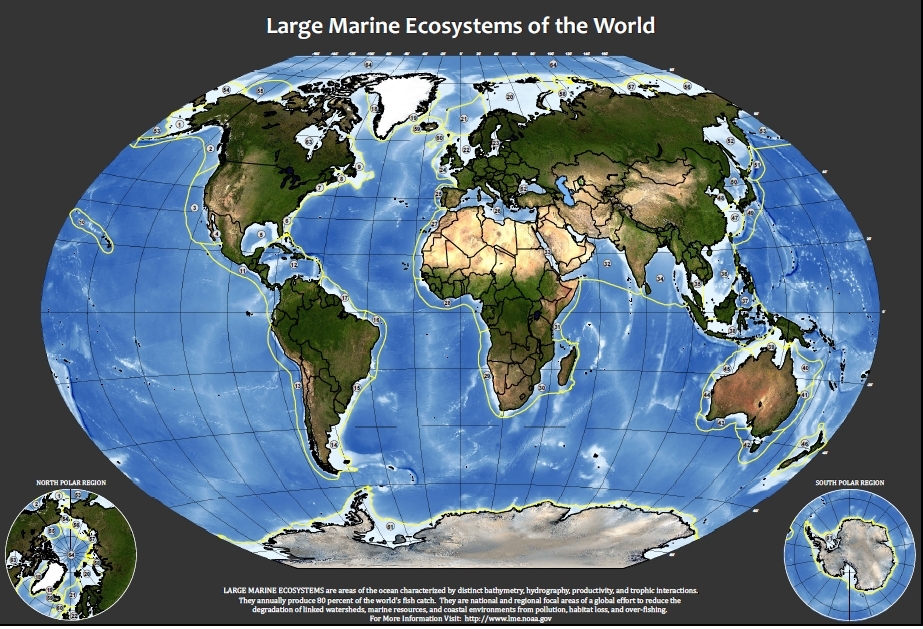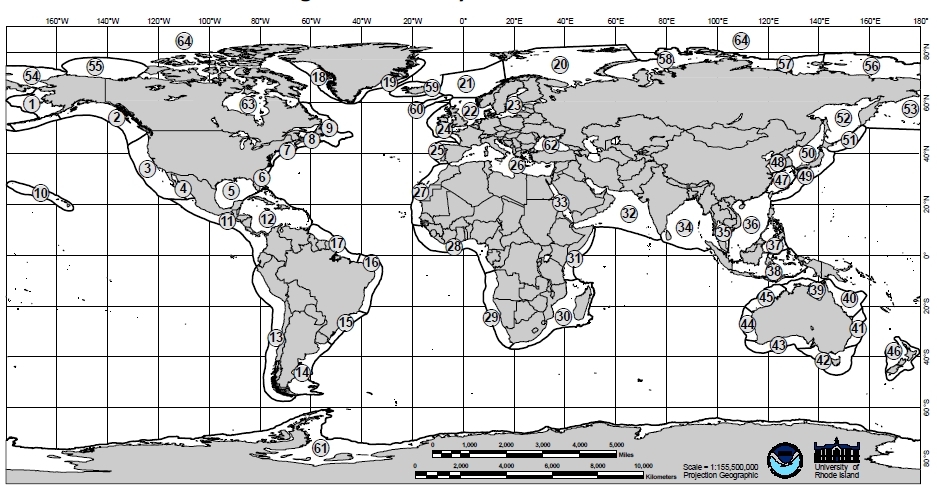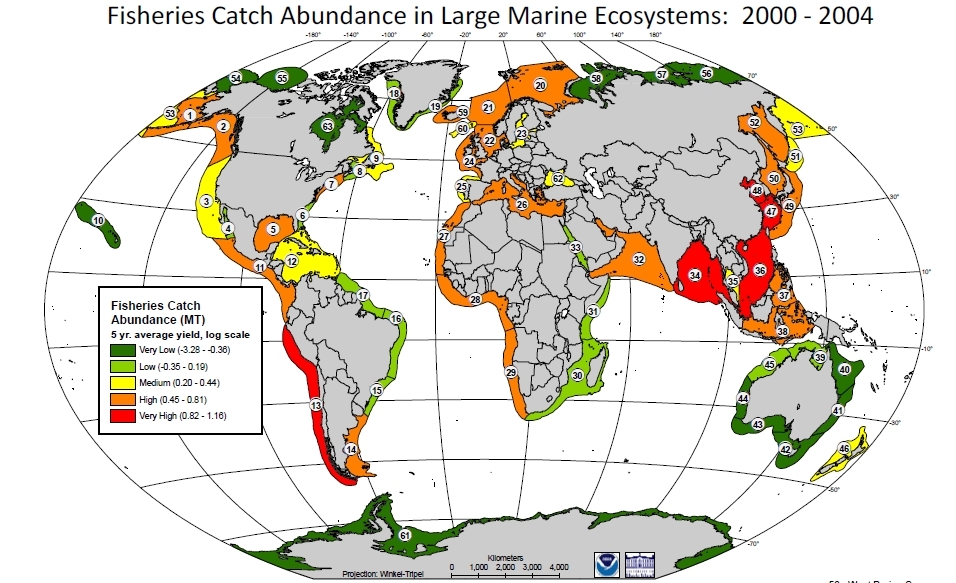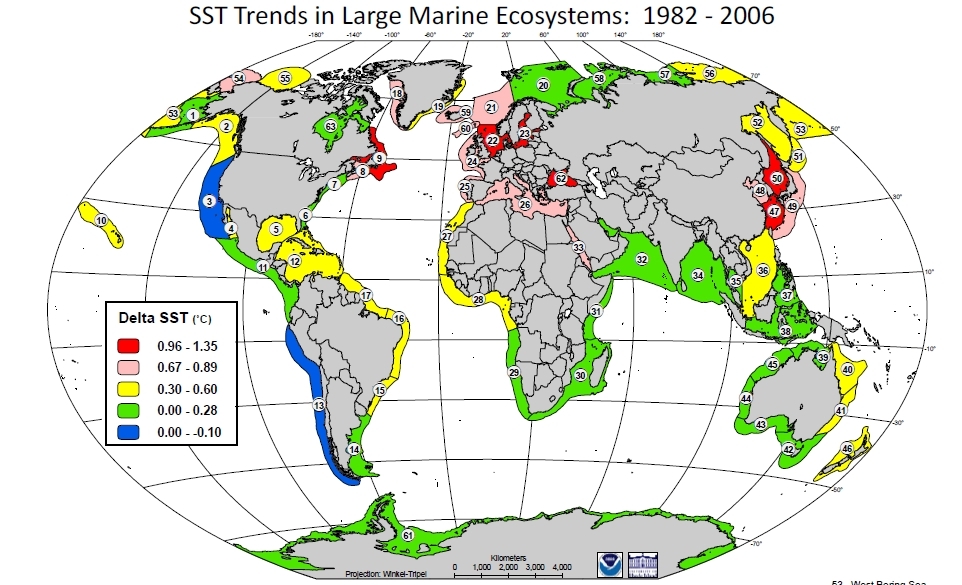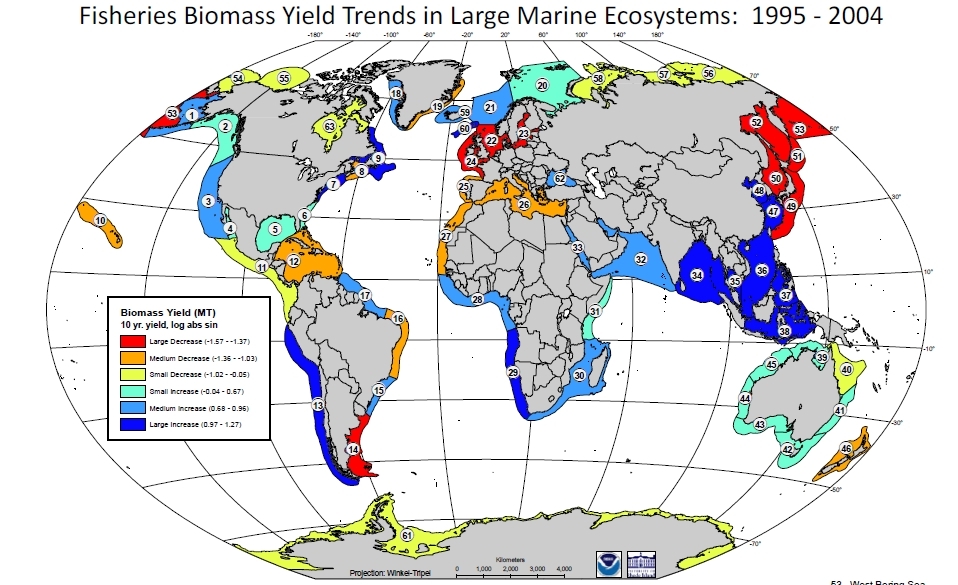Large marine ecosystems
The concept of large marine ecosystems (LME) emerged from an American Association for the Advancement of Science Symposium in the mid 1980s concerning the variability and management of large marine ecosystems[1]. Dr. Kenneth Sherman of the United States (US) National Oceanic and Atmospheric Administration’s (NOAA) National Marine Fisheries Service and Dr. Lewis Alexander of the University of Rhode Island pioneered the concept of LMEs. Sherman, Alexander, and several others around the world recognized that large areas of the oceans function as ecosystems, and that pollution from air (Air pollution), land, and water (Water pollution) and overexploitation of living resources, along with natural factors, influence the varying productivity of these ecosystems.
LMEs have been defined as regional oceans of ecological continuity extending from the top of a river basin to the end of the adjacent continental shelf and seaward boundaries of coastal current systems[2]. These areas are characterized by a combination of unique ecological criteria, bathymetry, hydrography, productivity and trophic relationships[3]. They constitute large areas on the order of 200,000 square kilometers or larger and are considered to be responsible for 95% of the total annual catch of global marine fisheries[4].
Sixty four LMEs have been identified around the world. The international community is very concerned with the deteriorating conditions of these ecosystems. Many of the 64 LMEs are at risk primarily as a result of pollution, over-fishing, habitat modification and habitat destruction. The consequences of these threats on ecosystem function and health, as well as the corresponding consequences to the global human population, is not known in empirical terms (ecosystem dynamics are non-linear, often with causes and effects separated by a variable time lag). However, the importance of marine and coastal area resources is undeniably substantial, thus mitigating the negative impacts of these threats and adopting management practices that sustain ecosystem function and health have become an international priority.
Contents
A modular approach to ocean management
An assessment and monitoring model with five linked modules has been developed for LME management[5][6]. These modules consist of:
- productivity,
- fish and fisheries,
- pollution and ecosystem health,
- socioeconomic conditions, and
- governance.
This five module approach was developed by NOAA to provide science based information for the monitoring (Environmental monitoring and assessment), conservation, and management of LMEs[7]. It constitutes an indicator-based model and modules have been defined and are consistent with the ideas behind an ecosystem-based management (i.e. they are driven by explicit goals, executed by policies, protocols, and practices, and made adaptable by research and monitoring, based on the best available understanding of the ecological interactions and processes necessary to sustain ecosystem composition, structure and function).
In this approach, indicators help assess the changing state of the coastal and [[marine] environment]. Examples of indicators of the productivity module are photosynthetic activity, zooplankton biodiversity and oceanographic variability. The fish and fisheries module uses biodiversity, finfish, shellfish, and demersal and pelagic species as indicators. Indicators of pollution and human health include eutrophication, biotoxins, pathology, emerging diseases and health indices. The socioeconomic module uses indicators of human forcing, sustainability of long-term socioeconomic benefits and integrated assessments. Finally, indicators of adaptive management and stakeholder participation are used in the governance module. The science-based modules (productivity, fish and fisheries, and pollution and ecosystem health) are designed to produce assessment information on which to recommend management decisions. Related socioeconomic and governance analysis are linked with the assessment to evaluate management options for resource sustainability. This modular approach to ocean management has proven a successful framework for comparative inferences with regard to global change among LMEs.
Since 1991, NOAA has taken the lead in providing scientific and technical assistance implementing the five module approach in developing countries interested in mitigating the negative impacts of coastal and marine threats and adopting management practices that sustain ecosystem function and health at the LME scale[8].
LMEs worldwide
Since the inception of the LME concept in the mid 1980s, governments, international organizations and scientists worldwide have embraced the LME concept. From the original peer-reviewed volume of publications in 1989, the concept has achieved worldwide recognition. The World Conservation Union (IUCN) (World Conservation Union (IUCN)), the Intergovernmental Oceanographic Commission of the United Nations (UN) Educational, Scientific and Cultural Organization, other United Nations agencies such as the UN Development Programme, UN Environmental Programme and UN Industrial Development Organization, and NOAA have partnered to improve the long-term sustainability of the world's LMEs[9].
Examples of the relevance of the LME concept worldwide are, (i) the UN Environment Programme adopted the LME as the basic unit for its regional seas activities; (ii) in the US the Presidents’ 2005 Ocean Action Plan recommends LMEs as the unit for marine resource management; and (iii) twelve peer-reviewed scientific volumes have been published containing descriptions and case studies of LMEs[10].
LME funding
Since its creation in 1991, the Global Environment Facility (GEF) has supported with grants the implementation of this ecosystem assessment model and management framework for LMEs and linked watersheds. This is done with the scientific guidance of NOAA and in collaboration with national governments in Asia, Africa, Central and South America, and Eastern Europe. The GEF is an organization established as an independent financial entity in partnership with the UN Development Programme, the UN Environment Programme and the World Bank and serves as a means to finance the international conventions on biodiversity, climate change, persistent organic pollutants, and desertification.
The focus of LME projects has been to promote commitments supported by countries addressing policy, legal and institutional reforms that change human actions in economic sectors that impose environmental pressure on [[coastal] ecosystems]. Ultimately, the goal is to introduce the ecosystem-based approach, integrate and analyze data from the five indicator modules described above, and transfer the results into management actions focused on long-term resource sustainability[11].
Most LMEs extend across multiple country boundaries; therefore, one of the first processes to emerge when this situation occurs is a Transboundary Diagnostic Analysis (TDA). The purpose of this type of analysis is for countries to cooperatively begin to address coastal and marine issues by undertaking a planning process that includes identifying transboundary concerns, analysis of scientific data pertaining to those concerns and identifying their cause. A subsequent emerging process is one of prioritizing actions that address those concerns; this process results in the development of a Strategic Action Program (SAP).
Since the creation of the LME Program in 1991, developing coastal nations have approached NOAA and GEF for assistance in restoring and protecting their coastal and marine ecosystems. The response has been favorable with numerous LME projects funded that promote commitments supported by countries addressing policy, legal and institutional reforms. These reforms target changes in economic sectors that impose environmental pressure on coastal ecosystems. Since 1991, more than 30 projects in 17 LMEs (including 110 countries) for $40 million US dollars[12].
List of LMEs of the world
References
Further reading
- Alexander, L.M. 1993. Large marine ecosystems: a new focus for marine resources management. Marine Policy 17: 186-198.
- Christensen, N.L., A.M. Bartuska, J.H. Brown, S. Carpenter, C. D'Antonio, R. Francis, J.F. Franklin, J.A. MacMahon, R.F. Noss, D.J. Parsons, C.H. Peterson, M.G. Turner, and R.G. Woodmansee. 1996. The report of the Ecological Society of America Committee on the scientific basis for ecosystem management. Ecological Applications 6: 665-691.
- GEF. 2005. Achieving the millennium development goals: a GEF progress report. Global Environment Facility, Washington, D.C., 25 pp.
- Griffis, R.B., and K.W. Kimball. 1996. Ecosystem approaches to coastal and ocean stewardship. Ecological Applications 6: 708-712.
- IOC. 2008. UN Atlas of the Oceans. Intergovernmental Oceanographic Commission.
- Large marine ecosystems. 2007. Large marine ecosystems: information portal.
- Murawski, S.A. 1996. Can we manage our multispecies fisheries? In Sherman, K., N.A. Jarowski, T.J. Smayda, Eds. The Northeast Shelf ecosystem: assessment, sustainability, and management. Blackwell Science, Cambridge, MA, 491-510. ISBN: 0865424683.
- NOAA. 2003. Large marine ecosystems of the world. IUCN - NOAA - IOC.
- Sea Around Us. 2008. Large marine ecosystems. Sea Around Us Project, Fisheries Centre, University of British Columbia, Vancouver, Canada.
- Sherman, K. 1994. Sustainability, biomass yields, and health of coastal ecosystems: and ecological perspective. Marine Ecology Progress Series 112: 277-301.
- Sherman, K., L.M. Alexander, and B.D. Gold (Eds.). 1991. Food chains, yields, models, and management of large marine ecosystems. American Association for the Advancement of Science - Westview Press, Boulder, 320 pp. ISBN: 0813383862.
